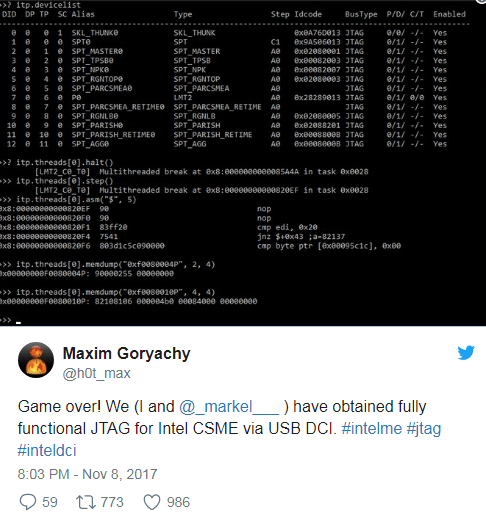Intel’s management engine – in most Positive Technologies plans to demonstrate at the next Black Hat conference how to hack over USB into Intel Management Engine of most CPUs since 2008.
Experts from Positive Technologies that in September announced to have devised a technique a toattack the Intel Management Engine, now provided more details about it and plan to demonstrate the God-mode hack in December 2017.
The God-mode hack could be exploited by “an attacker of the machine to run unsigned code in the Platform Controller Hub on any motherboard,” experts devised a technique to access the Intel Management Engine (IME) from the USB port
The security issues affecting the IME were first reported in March by the security expert Maksim Malyutin of Embedi.
A critical remote code execution (RCE) vulnerability tracked as CVE-2017-5689 was discovered in the remote management features implemented on computers shipped with Intel Chipset in past 9 years.
The vulnerability affects the Intel Management Engine (ME) technologies such as Active Management Technology (AMT), Small Business Technology (SBT), and Intel Standard Manageability (ISM) and could be exploited by hackers to remotely take over the vulnerable systems.

The remote management features allow system administrators to remotely manage computers over an enterprise network. Such kind of features are implemented only in enterprise solutions and doesn’t affect chips running on Intel-based consumer PCs.
“There is an escalation of privilege vulnerability in Intel® Active Management Technology (AMT), Intel® Standard Manageability (ISM), and Intel® Small Business Technology versions firmware versions 6.x, 7.x, 8.x 9.x, 10.x, 11.0, 11.5, and 11.6 that can allow an unprivileged attacker to gain control of the manageability features provided by these products. This vulnerability does not exist on Intel-based consumer PCs. ” reads the advisory published by Intel.
The vulnerability rated by Intel as highly critical could be exploited in two ways:
- An unprivileged network attacker could gain system privileges to provisioned Intel manageability SKUs: Intel® Active Management Technology (AMT) and Intel® Standard Manageability (ISM).
- CVSSv3 9.8 Critical /AV:N/AC:L/PR:N/UI:N/S:U/C:H/I:H/A:H
- An unprivileged local attacker could provision manageability features gaining unprivileged network or local system privileges on Intel manageability SKUs: Intel® Active Management Technology (AMT), Intel® Standard Manageability (ISM), and Intel® Small Business Technology (SBT).
- CVSSv3 8.4 High /AV:L/AC:L/PR:N/UI:N/S:U/C:H/I:H/A:H
An attacker can exploit the vulnerability to remotely access the vulnerable machine and perform in a stealth way malicious activities, including to deliver a malware.
Back to the present, experts were able to exploits the Joint Test Action Group (JTAG) debugging ports to target the IME.
In this blog post written in Russian language is confirmed that researchers at Positive Technologies have used the hardware debugging (JTAG) for Intel Management Engine, to gain full access to all PCH devices (Platform Controller Hub) using Intel Direct Connect Interface (DCI) technology (via USB interface).

Summarizing, the attack recently devised is possible by accessing to USB, Positive Technologies plans to demonstrate it at Black Hat.
Source:https://securityaffairs.co/wordpress/65327/hacking/intel-management-engine-flaw-hack.html

Working as a cyber security solutions architect, Alisa focuses on application and network security. Before joining us she held a cyber security researcher positions within a variety of cyber security start-ups. She also experience in different industry domains like finance, healthcare and consumer products.











